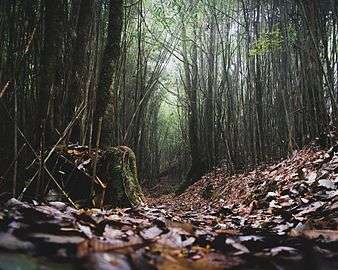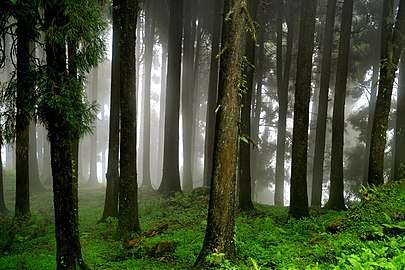Neora Valley National Park
Neora Valley National Park is situated in the Kalimpong district, West Bengal, India and was established in 1986. It spreads over an area of 88 km² and is one of the richest biological zones in the entire Eastern India. It is the land of the elegant red panda in the pristine undisturbed natural habitat with rugged inaccessible hilly terrain and rich diverse flora and fauna making this park an important wilderness zone.[1]
| Neora Valley National Park | |
|---|---|
IUCN category II (national park) | |
 A view of Neora Valley National Park | |
 | |
| Location | Kalimpong district, West Bengal, India |
| Nearest city | Kalimpong |
| Coordinates | 27°04′N 88°42′E |
| Area | 88 km2 (34 sq mi) |
| Established | 1986 |
| Governing body | Government of India, Government of West Bengal |
Geography
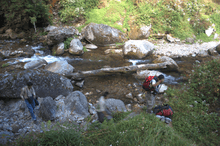
Neora Valley National Park covers an area of 88 km2 (34 sq mi) with an elevation of 183–3,200 m (600–10,499 ft).[2] The highest point is Rachela Danda. The forest in Neora Valley has such luxurious growth that even sunlight finds it difficult to touch the ground. Much of the park is still inaccessible, making it an adventurous place for the nature lovers/trekkers who can take the challenge to explore the still-unknown terrain in the Kalimpong hills. Virgin natural forests, dense bamboo groves, colourful canopy of Rhododendron trees, lush green valley, meandering rivers and streams with snowcapped mountains in the backdrop form a picturesque landscape.It borders Sikkim and Bhutan. The Neora River is the major water source for Kalimpong town.
Biodiversity
Avian fauna listed from this park are of A1, A2 and A3 categories with IBA site code IN-WB-06.[3]
Natural history
Biomes
Inside this wildlife sanctuary, the primary biomes corresponding to the ecozone are:[4]
- Sino-Himalayan Temperate Forest of the Eastern Himalayan broadleaf forests Biome 7
- Sino-Himalayan Subtropical Forest of the Himalayan subtropical broadleaf forests Biome 8
- Indo-Chinese Tropical Moist Forest of the Himalayan subtropical pine forests Biome 9
All of these are typical forest type of foothills of the Bhutan, Nepal, India hilly region between altitudinal range 1000 m to 3,600 m.
Flora[5]
Neora Valley, one of the last tracts of virgin wilderness in the country, sustains a unique ecosystem where tropical, sub-tropical, sub-temperate, and temperate vegetative system still harbours a wealth of flora and fauna. The forests consists of mixed species like rhododendron, bamboo, oak, ferns, sal, etc. The valley also has numerous species of orchids.
Fauna
Mammals reported from this area are Indian leopard, five viverrid species, Asiatic black bear, sloth bear, Asian golden cat, wild boar, leopard cat, goral, serow, barking deer, Sambar deer, Himalayan flying squirrel and tahr and the red panda. Among other endangered mammalian fauna, clouded leopards are seldom seen.[6] and likely to be present in the park.
Birds belonging to varied genus can be found in the park.[7][8] Neora Valley National Park thus is known as birders' paradise.[9]; some of India's most sought-after birds are found here in winter months as well. The semi-evergreen forests between 1600 m and 2700 m is the home of several rarities like rufous-throated partridge, satyr tragopan, crimson-breasted woodpecker, Darjeeling woodpecker, bay woodpecker, golden-throated barbet, Hodgson's hawk cuckoo, lesser cuckoo, brown wood owl, ashy wood pigeon, mountain imperial pigeon, Jerdon's baza, black eagle, mountain hawk eagle, dark-throated thrush, rufous-gorgeted flycatcher, white-gorgeted flycatcher, white-browed bush robin, white-tailed robin, yellow-browed tit, striated bulbul, chestnut-headed tesia, chestnut-crowned warbler, black-faced warbler, black-faced laughingthrush, chestnut-crowned laughingthrush, streak-breasted scimitar babbler, scaly-breasted cupwing, pygmy cupwing, rufous-fronted babbler, black-headed shrike babbler, white-browed shrike babbler, rusty-fronted barwing, rufous-winged fulvetta, brown parrotbill, fire-breasted flowerpecker, fire-tailed sunbird, maroon-backed accentor, dark-breasted rosefinch, red-headed bullfinch, gold-naped finch and many other rarities.
Like that of birds and mammalian fauna, reptilian fauna also coexists in park's ecosystem; which includes King cobra, common krait, green pit viper, blind snake, lizards etc. It is a heaven for Entomologists as well; many colorful insects such as butterflies, moths, beetles, bees, wasps, bugs and cicadas are added attractions of the valley.
Gallery
 Red Panda (Ailurus fulgens)
Red Panda (Ailurus fulgens)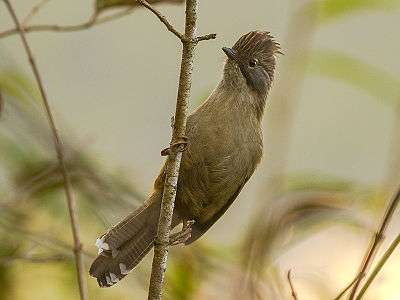 Hoary-throated Barwing (Actinodura nipalensis)
Hoary-throated Barwing (Actinodura nipalensis)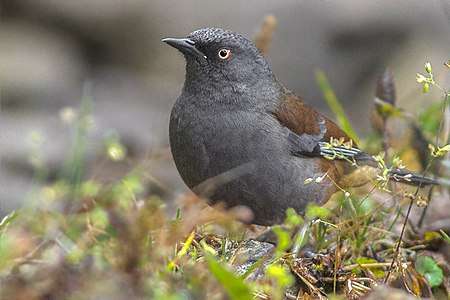 Maroon-backed Accentor (Prunella immaculata)
Maroon-backed Accentor (Prunella immaculata)
References
- Codrops. "WildBengal". www.wildbengal.com. Archived from the original on 5 March 2016. Retrieved 19 April 2018.
- Mallick, J. K. (2012). "Mammals of Kalimpong Hills, Darjeeling District, West Bengal, India". Journal of Threatened Taxa. 4 (12): 3103–3136.
- , West Bengal IBA categories Page-2.
- , West Bengal IBA categories Page-6.
- , An Ecological Journey to Pandam through Mulgaon Areas of Darjeeling Himalaya with Special Reference to Monitoring Of Vegetation in West Bengal, India.
- , IBA's in West Bengal – Page 20.
- , Annotated Checklist of Birds, cloudbirders
- , Key Avian Fauna, Birdlife International
- "Some Of The Best Bird Watching Spots In India". Petzenia Blog. 2016-12-04. Archived from the original on 2017-10-10. Retrieved 2017-10-10.
External links
- West Bengal Forest Development Corporation Ltd. - Lava
- UNESCO World Heritage Center - Tentative List
| Wikimedia Commons has media related to Neora Valley National Park. |


